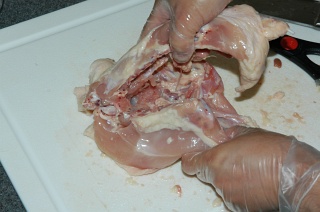 When working with a whole chicken, follow the Cutting Up Chicken instructions until you've removed the backbone.
When working with a whole chicken, follow the Cutting Up Chicken instructions until you've removed the backbone. Instead of splitting the breast, we'll want to remove the keel bone first. To easily accomplish this, we'll first need to break the wishbone - the Y shaped bone at the head end of the breast. Position the breast such that the skin-side is down on the cutting board and the cartilage is pointing away from you. Using the heel/base of your knife (shown below) or the tip of your knife cut the wishbone so the Y is separated into two pieces.
Instead of splitting the breast, we'll want to remove the keel bone first. To easily accomplish this, we'll first need to break the wishbone - the Y shaped bone at the head end of the breast. Position the breast such that the skin-side is down on the cutting board and the cartilage is pointing away from you. Using the heel/base of your knife (shown below) or the tip of your knife cut the wishbone so the Y is separated into two pieces.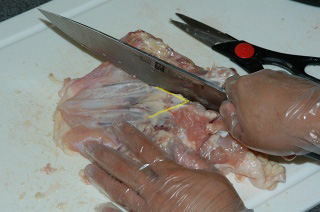 Next place short two diagonal cuts through the cartilage holding the tip of the keel bone in place - this should form a V shape.
Next place short two diagonal cuts through the cartilage holding the tip of the keel bone in place - this should form a V shape.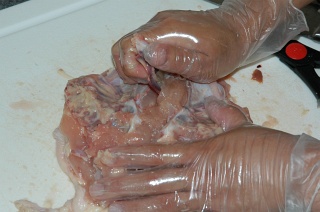 Turn the chicken around so the cartilage is pointing toward your body and dig your fingers into the area where you made the V shaped incision through the cartilage. Grab a hold of the keel bone and pull up and out.
Turn the chicken around so the cartilage is pointing toward your body and dig your fingers into the area where you made the V shaped incision through the cartilage. Grab a hold of the keel bone and pull up and out.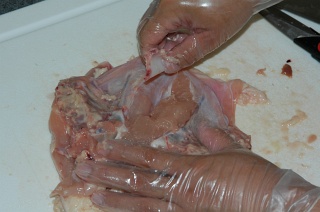 In most cases, the keel bone and the cartilage behind it will pull out of the chicken breast without a break. If this does not happen and the keel bone comes out without the cartilage, simply run your fingers under the cartilage to loosen it from the meat and then pull it out.
In most cases, the keel bone and the cartilage behind it will pull out of the chicken breast without a break. If this does not happen and the keel bone comes out without the cartilage, simply run your fingers under the cartilage to loosen it from the meat and then pull it out.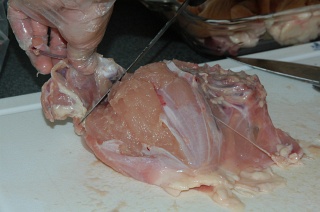 Next, remove the rib bones. I find it easiest to do by lifting the ribs from the point furthest away from the wishbone and cutting it away from the breast with a boning knife. Using short swiping cuts while lifting the ribs away lets you remove the ribs quickly and without taking too much meat with them. When you have almost completely removed the ribs, you'll get to the wishbone. Simply trim around the wishbone until it too has been removed from the breast. After repeating this operation on the other set of ribs, your chicken brest is boneless.
Next, remove the rib bones. I find it easiest to do by lifting the ribs from the point furthest away from the wishbone and cutting it away from the breast with a boning knife. Using short swiping cuts while lifting the ribs away lets you remove the ribs quickly and without taking too much meat with them. When you have almost completely removed the ribs, you'll get to the wishbone. Simply trim around the wishbone until it too has been removed from the breast. After repeating this operation on the other set of ribs, your chicken brest is boneless.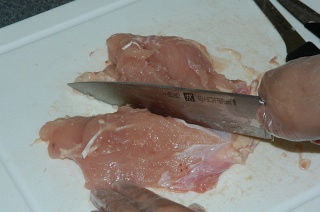 Cut the breast in half (cut where the keel bone used to be).
Cut the breast in half (cut where the keel bone used to be). The breast halves should each have a flap of meat called the chicken tenderloin (or chicken tenders or strips). Lifting the tenderloin should reveal a white tendon. I recommend two ways to trim off this tough tendon. The most popular method is to grab the tendon with your fingers and pull on it while scraping with your knife to release the tendon from the breast. Continue to lift and scrape until the tendon is completely removed. Alternatively, you can use a sharp boning knife and slice along both sides of the tendon (without slicing through the tendon). Then lift any part of the tendon that has been separated from the breast and use your boning knife the cut any parts where the tendon has not cleanly separated from the meat.
The breast halves should each have a flap of meat called the chicken tenderloin (or chicken tenders or strips). Lifting the tenderloin should reveal a white tendon. I recommend two ways to trim off this tough tendon. The most popular method is to grab the tendon with your fingers and pull on it while scraping with your knife to release the tendon from the breast. Continue to lift and scrape until the tendon is completely removed. Alternatively, you can use a sharp boning knife and slice along both sides of the tendon (without slicing through the tendon). Then lift any part of the tendon that has been separated from the breast and use your boning knife the cut any parts where the tendon has not cleanly separated from the meat. Repeat with the other breast. If you choose to, remove the skin at any convenient time (after removing the backbone or after boning has been completed or anytime in between).
Repeat with the other breast. If you choose to, remove the skin at any convenient time (after removing the backbone or after boning has been completed or anytime in between).Tools used:
- Kitchen shears to cut backbone off whole chicken
- Chef's knife to cut wishbone and cartilage
- Boning knife to cut up chicken, remove ribs, trim wishbone and tendon off
Related Articles

To debone the birds, you cut them down the back and chase the meat off the bone following the rib cage. You cut around the leg joints and chase the meat off the leg bones.
The result looks like a big fat turkey. When you slice through, you get each of the three birds and the three dressings.
Have you done a cost comparison of buying whole chickens and boning yourself vice buying boned parts?
Rick
It seems to me that the greatest value would be get chickens in a range of sizes (three perhaps? small, medium, and large?) and bone them. You could then report the ration of purchase weight and meat weight. Do the same for a couple of sectioned bits.
That makes the evaluation price independent and people can use the ratios (assuming we are all equally proficient at boning <grin>) to compare prices in the store. It is then up to each of us to decide what our time is worth, and the value of the bones and other leavings for making stocks and soups.
My thoughts.
Because raw chicken is pretty gross, I'd wager, and wearing gloves means you don't end up with chicken bits under your fingernails (or under-fingernail bits in your chicken, for that matter.)
heehee. actually, quite the opposite. gummymint FoodSafe type regulations requires the glove to keep the people from contaminating the (dead) chicken . . . .
like the sign says: Employees Must Wash Hands Before Returning to Work
like the sign says: Employees Must Wash Hands Before Returning to Work
Knowing the governement, I bet that sign's required even at an undertakers...